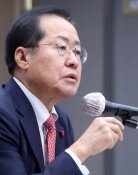Bank of Korea cuts interest rates amid economic concerns
Bank of Korea cuts interest rates amid economic concerns
Posted November. 29, 2024 08:03,
Updated November. 29, 2024 08:03

The Bank of Korea announced a benchmark interest rate cut on Thursday in a bid to stimulate the economy. However, the move, which came earlier than market expectations, has sparked concerns about its potential negative effects. Critics caution that the rate cut could further fuel the already rising won-dollar exchange rate—elevated since U.S. President-elect Donald Trump’s election victory—and reignite household debt risks, which had recently shown signs of stabilization.
The central bank’s decision to pursue back-to-back rate cuts, despite market skepticism, underscores its urgency to boost economic activity amidst uncertainty over exports and sluggish domestic demand. Nevertheless, a volatile foreign exchange market and the nation’s ballooning household debt remain pressing challenges. “Domestic demand is extremely weak, making a rate cut unavoidable,” said Park Hyeong-jung, an analyst at Woori Bank. “However, this decision is likely to have negative side effects, such as heightened exchange rates, inflationary pressures, and a further increase in household debt.”
The won-dollar exchange rate has been climbing steadily since President-elect Trump’s proposed tariff hikes. On November 13, the rate hit 1,410 won per dollar—the highest in two years—and has remained elevated around the 1,390-won range. Any further rise in the exchange rate could drive up import prices, adding to inflationary pressures on consumers.
Household debt risks also loom large. According to the Bank of Korea, outstanding household credit reached a record high of 1,913.8 trillion won at the end of September, up 18 trillion won from the previous quarter. Mortgage loans contributed the most, increasing by 19.4 trillion won. However, household debt growth slowed in the fourth quarter as authorities introduced regulations, including a two-tier stressed Debt Service Ratio (DSR) in September, and banks increased their lending thresholds.
신아형 abro@donga.com







